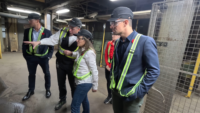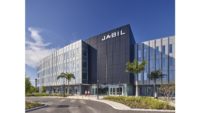This 160-unit residential co-op, constructed in 1961 in New York City’s Upper East Side neighborhood, was an early example of the white-glazed brick buildings that came to characterize the area’s development projects of that era. The original building design prioritized comfortable units with large, spacious rooms in keeping with the upscale neighborhood. But the economy of means also dictated a purely functional design of the façade.
As the building aged, façade safety inspections required by New York City’s Building Code uncovered structural and masonry failures that required repairs at significant cost and inconvenience to the building’s residents. Façade probes showed that the exterior had no insulation at all—and that in addition to the failing glazed face-brick, the back-up masonry had been poorly installed. In short, the façade was failing.
By 2018, it became clear that a full façade recladding was in order. A new architectural team was brought in to design new cladding for the building; they used the opportunity to also recommend a complete retrofit of the building envelope.

The Goal
Rogers Partners Architects + Urban Designers were initially approached as design consultants to reimagine and update the look of the exterior. Upon understanding the scope of the façade failures and the inadequacies of the original building construction, Rogers Partners recast the problem as an opportunity to upgrade the technical performance of the building envelope, especially in light of New York City’s “Local Law” 97-inch regulations requiring reductions to the energy usage of larger buildings.
Replacing the brick with new brick was not recommended because the original wall thickness left no room to add insulation. Besides, after their experience with brick repairs, building ownership had no interest in a new brick façade. Instead, Rogers Partners recommended upgrading the envelope by installing a high-performing rainscreen system that would improve thermal performance, acoustics, and comfort and safety for the residents. And the rainscreen cladding could be done using a variety of cladding materials, offering design flexibility to meet the aesthetic goals of the building owners.
The Challenges
There were multiple challenges facing the architects, on both the technical and design fronts. First, Rogers Partners knew that removal of the brick offered a chance to repair the holes in the deteriorating concrete block back-up that provided little to no protection from the elements or busy city streets. It was not uncommon for residents to feel drafts through electrical outlets and around windows, and exterior noise was also a regular complaint. Second, the retrofit was funded by the building’s owners; it was a substantial investment, so compromises were made to stay within the budget. One of those compromises was windows would not all be immediately replaced—that decision was left up to the individual owners—so the new window trim would need to be constructed in such a way to accommodate window replacement at a later time.
The fact that the building was occupied also came with challenges, since all demolition and new construction had to be achieved from the outside in order to minimize disturbance to the unit owners. And critically, ownership had raised real concerns about flammability issues associated with early generation rainscreen systems that left occupants vulnerable in the event of fire.




The Solution
The architects had no doubt that a rainscreen system was the solution that would allow them to address all the challenges presented. They proposed a cost-effective porcelain tile cladding material fastened with exposed clips. Zoning regulations permitted a 4” encroachment over the property line; this enabled them to expand the width of the exterior wall with the retrofit to allow room for a high-performance assembly designed to meet Passive House standards for the solid wall portion of the façade. And when it came to materials for the new building envelope, stone wool insulation was the first choice, primarily because of its superior fire-resilient properties as well as delivering thermal performance and comfort.
Rigid stone wool insulation boards were specified for the project. The building’s new façade used an open-joint system, requiring the assembly materials to meet needs for aesthetics and durability as well as energy efficiency. Where the insulating material is visible in these open-joint systems, boards with a bonded matte black layer of fleece don’t detract from the design. The stone wool products—both with the faced and unfaced options—provide exceptional moisture resistance and drying properties, making it an ideal component for rainscreen systems.
The metal framing for the new cladding was bolted into the original concrete block backing (now repaired and sealed with a liquid-applied membrane) and the stone wool boards were quickly and efficiently installed behind the framing. Around the windows, the architects designed a custom beveled-edge system that would accommodate the new envelope assembly for air tightness and still allow for the window units to be replaced and resealed at a later time.
Stone wool is easy to cut, enabling crews to trim the material to fit with the inconsistent detailing and spacing around original and newer window installations. The last stage of the assembly was attaching the porcelain tiles with an innovative clip system; the non-combustible tiles were an important component of the fire-resilient design of the entire assembly.
“We chose to specify stone wool insulation for this project because it met so many of our needs—and there were a lot of them,” says Alissa Bucher, Rogers Partners Architects + Urban Design. “The rainscreen assembly needed an insulation material that would deliver on thermal performance, fire protection, acoustics, and of course durability. It also needed to work with the design of the unique porcelain tile we chose for the façade. Stone wool was the go-to material. Four inches of rigid stone wool in these walls will help ensure that the new exterior will stand the test of time.”







